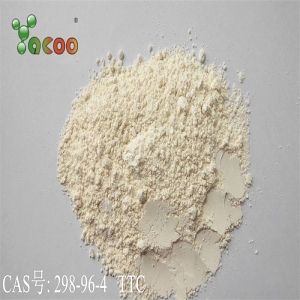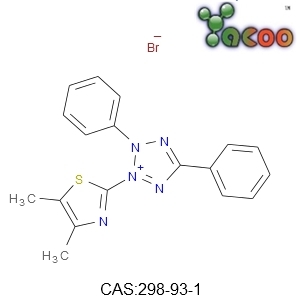2,3,5-Triphenyltetrazolium chloride (TTC) and thiazole blue (MTT) are both commonly used detection reagents, and are the most commonly used color reagents for detecting microbial activity. What is the connection between TTC and MTT, what are their characteristics, and what are the differences in nature and application? These will be introduced in the article.
2,3,5-Triphenyltetrazolium chloride(TTC), CAS number: 298-96-4, and its appearance is white to light yellow crystalline powder.

Thiazolyl Blue(MTT),CAS number: 298-93-1,and its appearance is yellow or orange powder.

The relationship between TTC and MTT:
Both TTC and MTT belong to the tetrazolium salt, which is a compound dye that can accept hydrogen ions, is positively charged, and has cell membrane permeability. The structure of TTC and MTT are similar, and the principle of color development is also the same: mainly by dehydrogenases such as succinate dehydrogenase of living microbial cells, which are reduced to water-insoluble colored formazan products.
The difference between TTC and MTT:
TTC is a redox substance with a standard redox potential of 80mV. It dissolves in water and becomes a colorless solution. The reduction product is dark red tribenzophenone. The product is relatively stable, insoluble in water and not easily oxidized by oxygen present in the air. It plays a long-term role in color development and has maximum absorption at 480-490nm wavelength.
MTT is easily dissolved by water and enters the cell through the cell membrane. It can be reduced by succinate dehydrogenase in living cells to produce blue-violet bismethylpyridine crystals, which are soluble in acidic isopropanol and dimethyl sulfoxide , SDS and other organic solvents, through the porous scanning spectrophotometer can be measured according to the color depth of each absorbance value, the maximum absorption at 550nm wavelength.
The application of TTC method and MTT method:
TTC is often used as an analytical reagent and a chromatographic reagent. The TTC method has a wide range of applications in the fields of biochemistry, pharmaceutical science, medicine, agriculture, high-energy materials, automotive industry, and photography. Specific applications are as follows:
(1) It is used to determine the total number of colonies, such as determining the total number of colonies in milk and dairy products, and distinguishing particles and colonies in cosmetics;
(2) It is used to identify cell vigor, mainly used to identify plant seeds, root systems and plant seed vigor;
(3) It is used for drug analysis to detect drug content, such as hydrocortisone, dexamethasone, etc.
The MTT method is widely used in the detection of bioactive factors, large-scale screening of anti-tumor drugs, cytotoxicity tests, and determination of tumor radiosensitivity due to its advantages of simplicity, speed, economy, and no use of isotopes. Specific applications are as follows:
(1) It is used to detect the number of viable bacteria of common bacteria such as Streptococcus mutans, Streptococcus sanguis, Haemophilus associated actinomycetes;
(2) It is used to determine the anti-tumor activity of Chinese herbal medicine extracts;
(3) It is used to observe the proliferation status of Toxoplasma gondii somatic cells under the action of walnut tree extract and assist its anti-toxoplasma effect.
In summary, TTC and MTT are chromogenic substrates with excellent performance and wide application.
Copyright © Suzhou Yacoo Science Co., Ltd. All Rights Reserved
Friendly Links :
online service